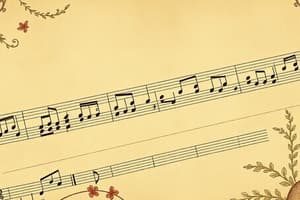Podcast
Questions and Answers
What does the term 'mezzo forte' refer to in music notation?
What does the term 'mezzo forte' refer to in music notation?
- Sudden accent
- Soft volume
- Slightly loud (correct)
- Gradually louder
How is the dimension of a melody determined?
How is the dimension of a melody determined?
- By its tempo
- By its length and range (correct)
- By the number of instruments playing it
- By the key signature
What does 'narrow range' in a melody signify?
What does 'narrow range' in a melody signify?
- The melody has a wide pitch distance
- The melody is in a high register
- The melody has a short length
- The melody has a pitch distance less than an octave (correct)
What does the term 'register' refer to in relation to a melody?
What does the term 'register' refer to in relation to a melody?
How is 'direction' defined when discussing the movement of a melody?
How is 'direction' defined when discussing the movement of a melody?
What does harmony in music refer to?
What does harmony in music refer to?
Which type of texture in music involves a single melodic line?
Which type of texture in music involves a single melodic line?
What is the most common type of chord in music?
What is the most common type of chord in music?
Which type of music is sung without instrumental accompaniment?
Which type of music is sung without instrumental accompaniment?
What is the main characteristic of Absolute music?
What is the main characteristic of Absolute music?
Flashcards are hidden until you start studying
Study Notes
Dynamics
- Mezzo-forte (mf): slightly loud
- Fortepiano (fp): loud, then soft
- Sforzando (sfz): sudden accent
- Crescendo (<): gradually louder
- Diminuendo (>): gradually softer
Melody
- Refers to the tune of a song or piece of music
- Properties of melody:
- Dimension: determined by length and range
- Length: short (<8 measures), moderate (8 measures), long (>8 measures)
- Range: moderate (octave), narrow (octave)
- Register: high, medium, or low
- Direction: upward, downward, static
- Progression: conjunct (stepwise), disjunct (numerous prominent skips)
Harmony
- Combination of notes (or chords) played together and their relationship
- Accompanies and supports the melody
- Created by playing a group of notes (simultaneously or as broken chords) behind the melody
- Triad: a combination of three tones (1st, 3rd, 5th or do, mi, sol)
Texture
- Refers to the number and type of layers in a composition
- Types of texture:
- Monophonic: single melodic line
- Polyphonic: two or more melodic lines
- Homophonic: main melody accompanied by chords
- Biphonic: two different, simultaneous melodies
- Heterophonic: slightly elaborated melody with one or two voices
- Thick texture: tones, chords, or voice parts closely spaced
- Thin texture: tones widely spaced
Forms
- Common forms of music:
- A cappella: choral music sung without instrumental accompaniment
- Chanson: song developed by troubadours and trouveres with French text
- Chorale: strophic religious song often sung by a congregation
- Anthem: religious or patriotic song
- Madrigal: contrapuntal song without accompaniment
- Aria: extended solo song, usually accompanied by an orchestra
- Opera: musical play
- Cantata: based on religious subject for a varied combination of soloists, chorus, and instruments
- Oratorio: sacred opera
- Overture: piece of orchestral music played at the start of an opera
- Sonata: composition usually in three movements with a formal pattern of fast, slow, and fast
- Chamber music: music played by an ensemble of two to nine instruments
- Symphony: piece of orchestral music based on the same principle of the sonata
- Concerto: composition for a solo instrument and orchestra
- Dance: music for particular dances
- Nocturne: romantic or dreamy piece, usually for piano
- Absolute music: instrumental music without a poem or story for its idea
- Program music: instrumental music built around a story or poem; also descriptive music
Studying That Suits You
Use AI to generate personalized quizzes and flashcards to suit your learning preferences.




